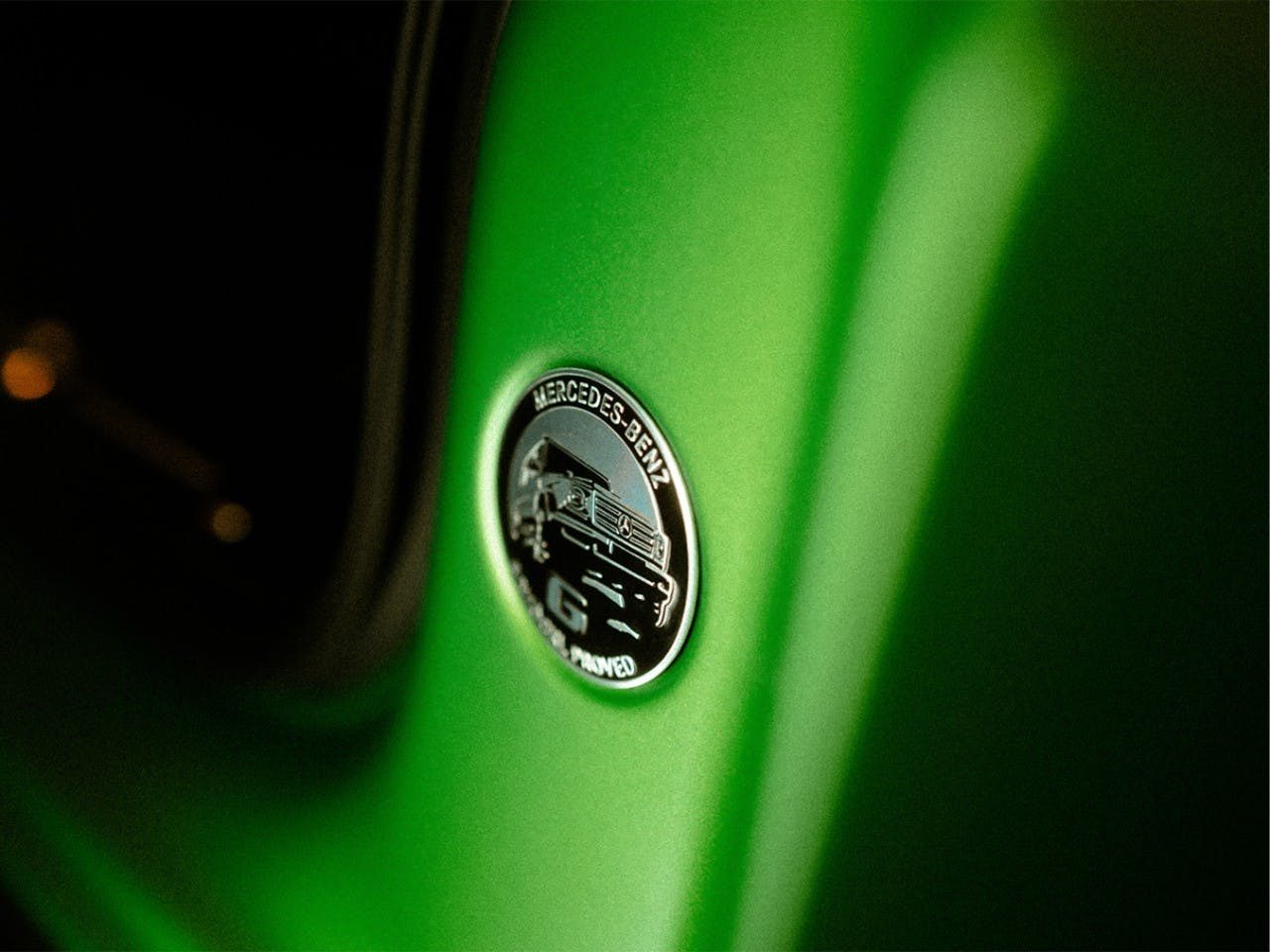Media | Articles
585-hp G-Wagen ends ICE era, electric GT40 is lighter than original, V-8 confirmed for F-150 Raptor R

G-Wagen ends V-8 era with 585-hp, portal-axle mic drop
Intake: Mercedes-AMG has unveiled a new top-dog variant of its iconic G-Class SUV. Meet the Mercedes-AMG G 63 4×4^2 (“four-by-four squared”), a portal-axled, high-clearance super ute ready to flatten entire mountains with the massaging seats set to waterfall. The 4×4^2’s party piece is undoubtedly the portal axles, which drop the wheel centers below the axle centers via complicated gear assemblies to significantly bolster key off-road metrics like wading depth (35.8 inches here), ground clearance (13.8 inches), and breakover angle (a whopping 40 degrees). For context, a Jeep Wrangler Rubicon’s breakover angle is 27.8 degrees. The G 63 4×4^2 features independent suspension at all four corners for precise wheel control and better on-road manner. An AMG-built 585-hp twin-turbo V-8 lives under the hood, offering 129 more ponies than you’d get in the non-AMG G 550. A permanent all-wheel-drive system shuffles torque where necessary, and, true to G-Class form, all three differentials—front, center, and rear—can be locked individually from buttons inside the cabin.
If the towering ride height somehow doesn’t let your neighbors know that you sprung for the ultimate G, massive 4×4^2 lettering on the carbon fiber spare wheel cover out back ought to do the trick. There are plenty of other carbon body elements too, from the fender cladding to the accent line running the length of the lower body. Other exterior niceties include 22-inch forged wheels and an optional roof rack. Inside, buyers will have the option to go hog wild with the personalization through Mercedes’ G Manufaktur program, which will offer 40 exclusive paint colors, plenty of tones for the nappa leather seats, and even a few shades for a trunk area clad entirely in wood. This G is the last of its kind, according to Mercedes, and limited availability means these are sure to go fast.
Exhaust: Our own Sam Smith once put the previous generation of G 4×4^2 through its paces at an off-road park in New York, while working for a previous publication. He called it many absurd titles, including “the German equivalent of a Gold’s Gym filled with ’roid-raging Disney cartoons.” The new G 63 4×4^2 will most certainly be the last hurrah for the gas-only G before the next generation goes pure-electric. Hell of a way to go out.
GT40 goes electric with 811 hp
Intake: Everrati certainly loves to stir the pot. The British specialist has already upset more than a few purists by converting classic Porsche 911s and Land Rovers to electric power, and now it’s taking on a true American icon–the GT40. However, this time, instead of using an original car as a donor Everrati has teamed up with Florida’s Superformance for an electrifying continuation model. Powered by two Integral Powertrain electric motors this GT40 packs a mighty 811 hp, dwarfing even the current GT’s 660 hp. Everrati claims it will hit 60 mph from rest in less than four seconds, and go on to a top speed of 125 mph. Its 60 kWh battery pack provides a range of 125 miles and comes with 700-volt architecture for rapid charging. Find a circuit with a CCS charger and you only need to pause your track day driving for 45 minutes to charge from 20 to 80 percent. With batteries in the sills and behind the driver the weight distribution is 40/60 front to rear, and, incredibly the car is actually lighter than a fully fuelled original, weighing in at 2910 pounds. Previous Everratis have featured a synthesized soundtrack but the GT40 goes even further with “virtual” gears. In Race mode the car will deliver a V-8 wail of up to 110 decibels through a pair of active sound generators, even pausing fractionally as it accelerates to simulate upshifts.
Exhaust: Isn’t this just a fake car with fake noise? Everrati and even Superformance say absolutely not—but we’re struggling to imagine the target audience. GT40 purists will reach for their pitchforks. Collectors aren’t likely to care. The motorsports-specific nostalgia play will be lost on most EV fans; those who want a vintage aesthetic with electric power tuned for the road will likely eye Everrati’s 911 conversion. Everrati’s solved a difficult packaging riddle with this conversion, but we don’t expect its electric GT40 to fly off the shelves.
Marketplace
Buy and sell classics with confidence
Ken Block’s Hoonipigasus sure has a lot of grunt
Intake: Ken Block’s Porsche 911 Pike’s Peak challenger has run for the first time. The Hoonipigasus is a tribute to the famous 917 Pink Pig which raced at the 24 Hours of Le Mans in 1971, but Block will only need to run flat out for under eight minutes to capture the record at the famous Colorado mountain. Block’s car is a carbon-fiber monster, with all-wheel drive and a twin-turbocharged flat-six engine which makes nearly 1500 hp. The car’s first shakedown took place at Pueblo Motorsports Park near Colorado Springs which, at around 4000 feet, sit at around one third of the altitude the car will have to cope with at Pikes Peak. Thankfully it’s also missing the mountain’s trees and massive drops as Block’s first test sees him fight some serious oversteer that will need to be tamed before his record attempt.
Exhaust: Ken Block’s target is seven minutes and 57.148 seconds, set by Romain Dumas in the electric VW ID.R in 2018. Will it be a win for internal combustion? We’ll find out on June 26.
Overheating modules force a Mustang Mach-E delivery pause and recall

Intake: Ford has ordered dealers to not demonstrate or deliver (i.e. they can still be sold) any Mustang Mach-E on the lot, and owners are being informed of a recall to address a problem with the Secondary On-Board Diagnostic Control Module (SOBDMC) and Battery Energy Control Module (BECM). The SOBDMC is known to weld itself together in an overheating condition, which causes a no-start condition. Over the air software updates are planned to address the BECM next month, while parts remain a TBD issue for the SOBDMC.
Exhaust: This is another recent reliability wart on Ford’s famous and popular vehicles. Ford has already delivered over 10,000 Mach-Es this year, and we do not know how many are affected by this recall. This news got our staff thinking big picture, to see the potential downsides of making electric cars with such rapid acceleration figures, and such rapid charging times. It makes us wonder if “heat management” is a bigger part of EV design than most people realize—and this could be evidence that nobody has it right just yet. And who knows what will happen when EVs are 12 years old and being operated without appropriate cooling system maintenance.
Officially official: V-8 to F-150 Raptor R
Can’t wait to share more details about F-150 Raptor R later this year. The V8 sounds amazing! #RaptorR pic.twitter.com/qTOxKvp1ll
— Jim Farley (@jimfarley98) June 14, 2022
Intake: If the new Jurassic World just wasn’t enough dinosaur action for you, we’re finally getting the T-Rex vs. Raptor fight we’ve always wanted: Ford’s CEO Jim Farley tweeted yesterday that the F-150 Raptor R would indeed get the supercharged 5.2-liter Predator V-8 from the Shelby GT500, placing it toe to toe with the Hellcat-powered Ram 1500 TRX. In the dust-filled teaser video, we can see the Super Raptor throwing huge plumes of sand accompanied by raucous V-8 noises and appropriate desert hoonage. We’ve seen spy shots of the Raptor R out and about, but this is the first time the factory has confirmed a V-8 powerplant, and the supercharger noises in the video seal the Predator deal. While the 450-hp, 3.5-liter twin-turbo EcoBoost V-6 found in the normal Raptor is no slouch, the Raptor R is is gonna be absolutely bonkers—especially if the power output is anything like the 760 hp in the Shelby. Sources say that we should expect somewhere between 725 and 750 hp, which trounces the TRX’s 702 hp figure. Farley said that more details on the Raptor R will be announced later this year—we’ll be perched on the edges of out seat until that day arrives.
Exhaust: At long last, the next round of the pickup wars comes into clearer focus. When you stuff an engine like the Predator or the Hellcat V-8 in a pickup vs. a street car, certain components must change to deal with the added weight. In the TRX, that meant a new deep-sump oil pan and a re-engineered exhaust, which ultimately cost the pickup a few ponies. Expect similar adjustments to Ford’s Predator when it’s situated between the Raptor’s frame rails.












































